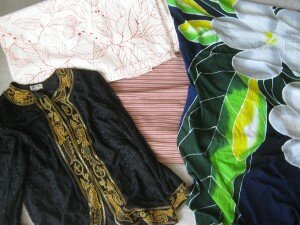The Austin Fiber Artists’ monthly presentations are wonderful ways to learn new things, with the added bonus of having people to share the experience with. During their presentation last month, the lace-maker speakers showed lace styles that I had previously encountered by reading historic romance novels but was unsure what they actually looked like. Sometimes the styles were distinguished by the technique used and sometimes by motif or design approach. It was an impressive survey of history- see the earlier blog entry for sample pictures.
Embroidery styles are more familiar to modern eyes and are also named for the technique or the design. Here’s a selection of pictures of embroidery types- can YOU match up the style to its name?
A) Assisi B) Bargello C) Broderie Anglais D) Drawn Thread E) Hardanger F) Cross-stitch G) Crewel H) Smocking

Assisi is a particular Italian style of counted cross-stick where the background is filled but the design motifs are outlined but not stitched. See the samples in picture #7.
Bargello, another Italian style, is a geometric satin stitch that is frequently used to make flame-like patterns. See picture #1 for examples.
Broderie Anglais, which means English Embroidery in French, is a form of cut-work where eyelets are bound with the button-hole stitch. It sometimes included satin stitched dots. See picture #8.
Drawn Thread Work is made by pulling out threads from the fabric, then sewing the remaining looser woven thread into bundles that make patterns of holes. See picture #4.
Hardanger is a particular type of drawn thread work, usually worked white thread on white, even weave cloth (cloth with the same number of threads measured along the width and the length). It uses square or other geometric blocks of satin stitches to enclose an area of the fabric, which is then cut to make a hole, as shown n picture #2.
Cross-Stitch is embroidery consisting of X-shaped stitches. It is usually done by counting thread of an even weave fabric but can be done following a printed design over any type of fabric. Picture 6 shows cross stitch on even weave fabric.
Crewel is surface design embroidery made using wool thread and a variety of stitches. Silk or cotton threads are sometimes used for shading or highlighting. Picture 3 shows crewel embroidery.
Smocking is embroidery done over pleated fabric. Gathering fabric is useful in clothes-making, such as such as taking in the fullness of a sleeve to form a cuff. If the embroidery is worked in a zigzag over the pleats, it is stretchy, which was useful in the days before elastic was invented. Picture 6 shows smocking.


















